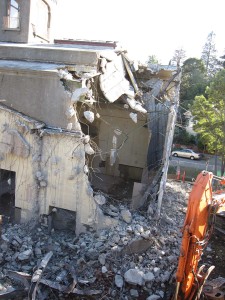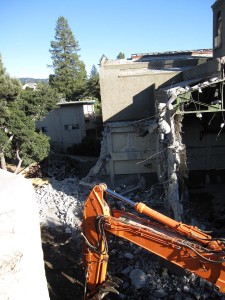Apr 27 2014
– Should a nonprofit organization endorsing and participating in a ballot measure campaign be allowed to use taxpayer funded public facilities and resources to disseminate information at an “impartial” forum? –
New legislation approved October 12, 2013, prohibits campaigning nonprofit organizations from using public resources and facilities. Sections 54964.5 and 54964.6 went into effect on January 1, 2014:
LEGISLATIVE COUNSEL’S DIGEST
This bill would prohibit a nonprofit organization or an officer, employee, or agent of a nonprofit organization from using, or permitting another to use public resources received from a local agency for campaign activity, as defined, and not authorized by law. This bill would define, among other terms, “public resources” to mean any property or asset owned by a local agency and funds received by a nonprofit organization which have been generated from any activities related to conduit bond financing by those entities subject to specified conduit financing and transparency and accountability provisions, and “nonprofit organization” to mean an entity incorporated under the Nonprofit Corporation Law or a nonprofit organization that qualifies for exempt status under the federal Internal Revenue Code of 1986, except as specified.
Election after election, Piedmont’s League of Women Voters (PLWV) has been allowed to use City or school facilities to conduct “forums” on ballot measures, which the League has already taken a publicized political position. In recent years, the PLWV has not only been allowed to conduct these events in Piedmont City Hall, but also had them video-taped, recorded, and disseminated using public taxpayer funds via Piedmont’s cable station KCOM and website.
(7) “Public resources” means the following:
(A) Any property or asset owned by a local agency, including, but not limited to, cash, land, buildings, facilities, funds, equipment, supplies, telephones, computers, vehicles, travel, and local government compensated work time that is provided to a nonprofit organization, except funds received in exchange for consideration for goods or services.
The League considers itself to be nonpartisan because it is not affiliated with a particular political party or candidate. However, the League is partisan in its support of numerous City, County and State ballot measures. As members know, their Piedmont League of Women Voters membership dues are not tax deductible because of the League’s political advocacy, actions and positions for and against ballot measures and legislation. Read current League of Women Voters “Take Action” instructions.
Read the newly added section to the Government Code.
On April 7, the Piedmont League of Women Voters Board of Directors held a private debate in the home of their president and new Piedmont resident Hope Salzer on the pros and cons of the Alan Harvey Theater School Bond, Measure H.
“Measure H is a Piedmont Unified School District bond measure. It seeks voter approval to authorize the District to issue and sell bonds of up to $13,500,000 to finance modernization of the Alan Harvey Theater at Piedmont High School. To pass, the measure must be approved by 55% of the voters.”
Unknown to the majority of approximately 150 Piedmont League members and the public, the Board undertook a controlled debate on Measure H. Invited to a portion of the meeting was a Piedmont Post reporter, who was present during the debate. No other media representatives were included.
Presentations were made to “twelve” board members on the pros and cons of the measure. The League Board was joined at the “debate” by League member and Board of Education Vice President Andrea Swenson, who is supportive of Measure H although not currently a League Board member. Swenson responded to questions after the debate, but, according to reports, did not vote.
The League Board is entitled to make endorsements without general membership approval, notification, knowledge or participation. Only current Board members are allowed to vote on endorsements. The Board members’ votes were made in private and have not been disclosed publicly, but according to the Post report, support for Measure H was not unanimous, however endorsement of Measure H by the League was won.
The League’s endorsement of Measure H is considered a campaign activity making the League a partisan nonprofit organization prohibited from using public facilities.
An exception in the legislation for the use of public resources is made for the presentation of impartial information.
“(c) This section does not prohibit the use of public resources for providing information to the public about the possible effects of any ballot measure on the activities, operations, or policies of the state or a local agency, provided that the informational activities meet both of the following conditions:
(1) The informational activities are not otherwise prohibited by the California Constitution or the laws of this state.
-
The information provided constitutes an accurate, fair, and impartial presentation of relevant facts to aid the electorate in reaching an informed judgment regarding the ballot measure.”
Significantly, the Piedmont League’s public notice of their May 1 forum in City Hall acknowledges League support of Measure AA, a Healthcare Safety Net, while making no mention of the Piedmont League of Women Voter’s support and endorsement of Measure H.
In the past, the League has attempted to hide their campaign endorsements prior to and during forums. Yet currently, the public has been notified in a local newspaper of the League’s ballot measure support position revealing the League’s partiality.
The League states it will hold a “completely neutral” forum “so that citizens can hear arguments for and against” their supported ballot measures. The forum is to be recorded, broadcast, rerun, and held at taxpayers expense.
The previous privately held debate on the local tax measure by the League Board of Directors is in contrast to Piedmont League public forums. The private debate allowed presentations both pro and con followed by unscreened questions. Providing an opportunity for impartiality at the public forums, audience members who have a question must submit their questions in writing or by text message to a League committee to be screened privately prior to a question being asked of presenters. Not all questions are publicly asked.
The League has taken a political position and is involved in current election campaigns raising the question of compliance with the new definitions and requirements in California law. Voters and City officials know the League’s political positions on ballot Measure H and now Measure AA.
Does the May 1 forum meet legal requirements?
Can a nonprofit organization supporting ballot measure campaigns use public resources for a political forum?
Would the City permit any nonprofit organization’s use of City taxpayer resources, if the organization was opposed to a City supported tax measure, even if the organization promised impartiality?
Editors’ Note: The Piedmont Civic Association does not support or oppose ballot measures or candidates for public office. The article above is not intended as opposition to Measure H.




